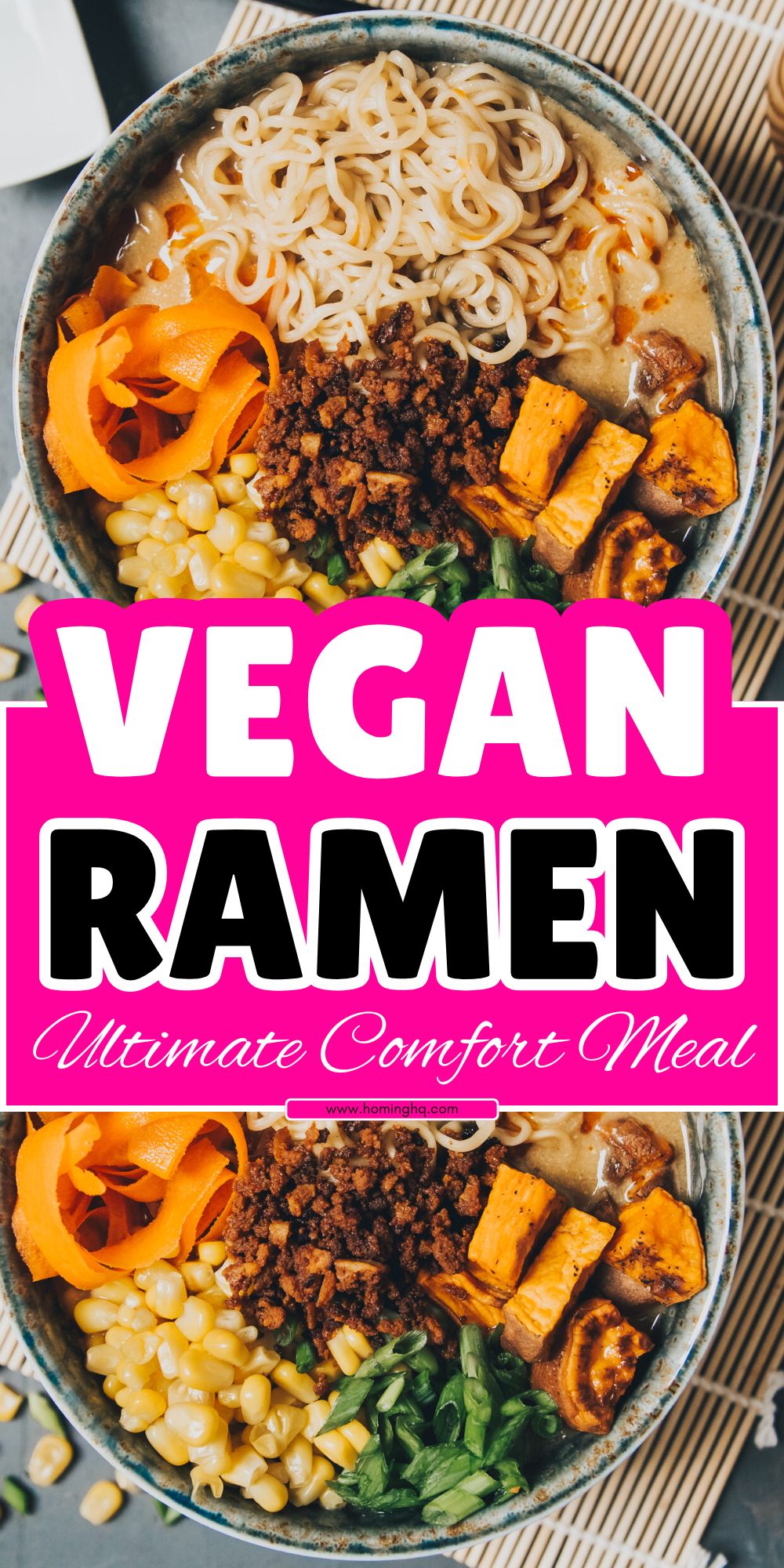Vegan ramen is a comforting and flavorful dish that brings the warmth and complexity of traditional Japanese ramen to the plant-based table.
While ramen often includes animal-based broths and toppings, this vegan version is entirely plant-based without compromising on taste.
The beauty of vegan ramen lies in its versatility—you can create a delicious bowl using a variety of broths, noodles, and toppings.
Whether you’re a seasoned vegan or simply looking to enjoy a lighter, cruelty-free meal, this vegan ramen recipe is bound to satisfy your cravings.
In this post, we’ll guide you step-by-step on how to make the perfect bowl of vegan ramen that’s rich in umami and filled with delightful textures.

The Essential Ingredients for Vegan Ramen
When it comes to making vegan ramen, the key to success lies in selecting the right ingredients.
Each component—from the broth to the noodles and toppings—comes together to create a rich and satisfying dish.
Let’s take a closer look at what you’ll need:
Vegan Broth Options
The broth is the heart of any great ramen. For vegan ramen, there are a few flavorful broth options that stand in for the traditional meat-based stocks. Here are the most popular choices:
- Miso Broth: This rich, salty, and umami-packed base is made by dissolving miso paste (fermented soybean paste) in a combination of water or vegetable stock. It’s a common and beloved option for vegan ramen, offering a deep, savory flavor.
- Soy Sauce Broth: If you prefer a lighter, slightly tangy broth, soy sauce (or tamari for gluten-free) is an excellent choice. Often combined with vegetable stock and a few seasonings, this broth is perfect for a delicate yet satisfying bowl.
- Coconut Milk Broth: For those who like a creamy and slightly sweet broth, coconut milk offers a fantastic alternative. It pairs well with curries and gives the ramen a smooth texture.
Noodles
Most traditional ramen noodles are already vegan-friendly, as they’re made from just wheat flour, water, and salt.
The texture of ramen noodles is key to the overall experience, so choosing the right ones can make a significant difference.
You can go for store-bought noodles, or for the extra touch, make your own fresh ramen noodles at home.
Toppings
Toppings are where you can get creative! A well-balanced ramen bowl includes a variety of textures and flavors to complement the rich broth. Here are a few essentials to consider:
- Tofu: Whether you choose crispy fried tofu or soft silken tofu, it provides a great protein boost and texture contrast.
- Mushrooms: Shiitake, oyster, or button mushrooms work wonderfully, adding an earthy flavor and umami depth.
- Vegetables: Leafy greens like spinach or bok choy, sweet corn, and bamboo shoots add freshness and crunch.
- Aromatics: Scallions, garlic, and ginger help to enhance the flavor of the broth and add an aromatic punch.
- Optional Garnishes: Nori (seaweed), sesame seeds, chili flakes, or pickled ginger can all be added for extra flavor and visual appeal.
How to Make Vegan Ramen Broth from Scratch

The broth is the soul of ramen, and making it from scratch brings unmatched flavor.
While it may seem intimidating, preparing a vegan broth is relatively simple.
Here’s how to make a vegan ramen broth that’s rich, flavorful, and full of depth:
Step 1: Choose Your Base
Decide which broth you want to create—miso, soy sauce, or coconut milk. Each has its own unique flavor profile, but they all provide a satisfying base for your ramen.
For this guide, we’ll focus on a miso-based broth, which is easy to make and deeply satisfying.
Step 2: Sauté Aromatics
Start by heating a bit of sesame oil in a large pot over medium heat. Add chopped garlic, ginger, and green onions, and sauté until fragrant, about 2-3 minutes.
This will help to release the natural oils and flavors from these ingredients, creating a rich aromatic base.
Step 3: Add Broth Base
Once the aromatics have softened, pour in your vegetable stock or water (about 4 cups) and bring it to a simmer.
If you’re using miso, whisk in 2-3 tablespoons of miso paste. Make sure to stir the miso paste thoroughly to dissolve it into the liquid.
This is where you’ll start to build the rich, savory depth of the broth.
Step 4: Season the Broth
To deepen the flavor of the broth, add a splash of soy sauce or tamari, and a teaspoon of sesame oil.
You can also add a small piece of kombu (dried seaweed) or a couple of dried shiitake mushrooms if you’d like to introduce extra umami.
Let the broth simmer for 20-30 minutes to allow all the flavors to meld together.
Step 5: Taste and Adjust
Taste the broth and adjust the seasonings according to your preference. If you want more depth, a small spoonful of miso or soy sauce can help.
If you like it saltier or spicier, you can add a bit of chili paste or more soy sauce.
A splash of rice vinegar can also be added to balance the flavors with a slight tang.
Step 6: Strain and Serve
Once your broth is rich and flavorful, strain out any large chunks of ginger, garlic, and aromatics (if you prefer a smoother broth).
Now your base is ready for the noodles and toppings. Ladle the broth into bowls, and you’re ready to assemble the perfect bowl of vegan ramen!
Tips for Making the Best Vegan Ramen
To ensure your vegan ramen is absolutely delicious, here are some helpful tips that can elevate your dish:
1. Layer Flavors for Depth
Ramen broth is all about layering flavors. Start by sautéing garlic, ginger, and green onions to build a solid base.
Then, use a variety of umami-rich ingredients like miso, tamari, and mushrooms to deepen the broth.
Don’t rush; allow the broth to simmer and develop complexity.
2. Don’t Overcook the Noodles
Perfect ramen noodles have a slight bite to them, so it’s crucial not to overcook them.
Follow the package instructions, but keep a close eye on the noodles as they cook.
Once they’re al dente, drain and set aside. They will continue to cook slightly when you add them to the hot broth.
3. Customize Your Toppings
The toppings are what make your ramen truly unique. Consider adding sautéed mushrooms, crispy tofu, or roasted vegetables for texture contrast.
If you like a little spice, drizzle some chili oil or add fresh chili slices for an extra kick.
4. Adjust Broth to Your Preference
The beauty of vegan ramen is its versatility. Taste the broth and tweak the seasoning to match your preferences.
If you want a spicier broth, add some chili paste or hot sauce. For a more robust flavor, a spoonful of miso can do wonders.
Balance out salty and sweet notes to get the perfect harmony.
5. Garnish for Extra Flavor and Texture
Finish your ramen with a sprinkle of sesame seeds, a few nori strips, or a dash of chili flakes to add an extra burst of flavor.
The garnish not only enhances the visual appeal but also gives your bowl of ramen an extra textural layer.
Vegan Ramen Variations and Add-Ins
One of the most exciting aspects of vegan ramen is how easy it is to personalize.
Here are a few variations and add-ins you can experiment with to keep things interesting:
1. Spicy Vegan Ramen
If you’re a fan of heat, make your ramen spicy by adding chili paste, chili oil, or fresh chopped chilies to the broth.
You can also toss in some spicy miso for an extra fiery depth.
2. Coconut Curry Vegan Ramen
For a creamy twist, swap your traditional miso or soy-based broth for a coconut milk base.
Add curry paste, turmeric, and lime for a rich, fragrant, and tropical flavor. Top with roasted vegetables and fresh cilantro for a vibrant touch.
3. Vegan Kimchi Ramen
For a tangy, fermented punch, try adding vegan kimchi to your ramen.
The spicy and sour flavors of kimchi pair perfectly with the rich broth and provide an extra probiotic boost.
4. Tofu or Tempeh Add-Ins
Tofu can be added in various ways—either crispy fried, pan-seared, or soft and silken for a smoother texture.
Tempeh is another great protein option, especially if you want a more hearty addition.
Both tofu and tempeh absorb the flavors of the broth and toppings beautifully.
5. Sweet and Sour Vegan Ramen
For a different flavor profile, add a splash of rice vinegar or tamarind paste to your broth to introduce sweet and sour notes.
Top with roasted squash, bok choy, and crispy chickpeas for a unique, flavorful twist.
Conclusion
Vegan ramen is a wonderfully versatile dish that allows you to experiment with different broths, noodles, and toppings.
Whether you prefer a rich miso base, a creamy coconut milk broth, or a spicy soy sauce flavor, this plant-based twist on the classic ramen will not disappoint.
By following the steps to make your broth from scratch and experimenting with creative toppings and add-ins, you’ll have a meal that’s both nourishing and incredibly satisfying.
With endless variations to try, you can make your ramen as unique as your taste buds desire.
Give this vegan ramen recipe a go, and enjoy a bowl of comfort that’s full of flavor and plant-based goodness.
Frequently Asked Questions (FAQs)
1. Can I use store-bought broth for vegan ramen?
Yes, store-bought vegetable broth can be a quick and convenient base for your ramen.
Just be sure to choose one that’s flavorful and free from animal products. You can still enhance it with miso, soy sauce, or other seasonings.
2. Are ramen noodles always vegan?
Most ramen noodles are made with wheat flour, salt, and water, making them vegan-friendly.
However, it’s important to check the ingredients as some varieties may contain egg or other animal-based products.
3. How can I make vegan ramen gluten-free?
To make gluten-free vegan ramen, simply swap the traditional ramen noodles for gluten-free noodles, such as rice noodles or gluten-free pasta.
Ensure that the broth ingredients are also gluten-free by using tamari instead of soy sauce.
4. How long can I store leftovers?
You can store leftover ramen broth and toppings separately in the fridge for up to 3 days.
Reheat the broth gently and add freshly cooked noodles when you’re ready to serve. Avoid reheating the noodles multiple times, as they may become soggy.
5. Can I freeze vegan ramen broth?
Yes, vegan ramen broth can be frozen for future use. Let the broth cool completely before transferring it to an airtight container.
It can be frozen for up to 3 months.
When you’re ready to use it, simply defrost it in the refrigerator overnight or reheat it directly on the stove.

Vegan Ramen
Equipment
- 1 Large Pot (for broth)
- 1 medium pan (for sautéing vegetables/tofu)
- 1 Cutting Board
- 1 Sharp knife
- 1 whisk (optional for miso paste)
- 1 slotted spoon (for draining noodles)
- 4 ramen bowls (for serving)
Ingredients
For the Broth:
- 4 cups vegetable broth
- 2 tbsp miso paste white or red
- 2 tbsp soy sauce or tamari
- 1 tbsp sesame oil
- 1 tsp rice vinegar optional
- 2-3 cloves garlic minced
- 1- inch piece fresh ginger grated
- 2 green onions chopped
- 1 tbsp dried shiitake mushrooms optional, for umami
For the Noodles:
- 4 servings ramen noodles or gluten-free noodles
For the Toppings:
- 1 block firm tofu cubed and fried or sautéed
- 1 cup spinach or bok choy chopped
- 1 cup corn kernels fresh, frozen, or canned
- 1/2 cup mushrooms shiitake, oyster, or button, sliced
- 2 tbsp sesame seeds optional
- 2 sheets nori cut into strips (optional)
- Chili flakes or chili oil optional for spice
Instructions
Prepare the Broth:
- In a large pot, heat sesame oil over medium heat. Add garlic, ginger, and green onions, and sauté until fragrant (about 2-3 minutes). Add vegetable broth and bring to a simmer. Whisk in miso paste and soy sauce (or tamari) until the miso is dissolved. Add rice vinegar, dried shiitake mushrooms (optional), and let the broth simmer for 20-30 minutes to develop flavors.
Prepare the Noodles:
- While the broth simmers, bring a separate pot of water to a boil. Cook the ramen noodles according to the package instructions (usually 4-5 minutes for store-bought ramen). Drain and set aside.
Prepare the Toppings:
- In a medium pan, sauté tofu cubes until golden brown and crispy, about 7-8 minutes. Set aside. In the same pan, sauté mushrooms until soft, about 5 minutes. Set aside. Prepare the other toppings—chop the spinach, and prepare any additional vegetables you like.
Assemble the Ramen Bowls:
- Divide the cooked noodles between 4 bowls. Pour the hot broth over the noodles. Top with sautéed tofu, mushrooms, spinach, corn, and any other toppings you desire (like sesame seeds, nori, or chili flakes).
Serve and Enjoy:
- Garnish with your favorite toppings and serve immediately. Enjoy the rich flavors of your homemade vegan ramen!
Notes
- You can customize the broth by adding other seasonings like tamari, chili paste, or nutritional yeast for extra umami.
- If you don’t have miso paste, you can substitute with tahini or almond butter, but the flavor will differ slightly.
- To make the ramen spicier, add chili flakes or chili oil to the broth or as a garnish.
- If you prefer a creamier texture, you can use coconut milk as the base instead of vegetable broth.

